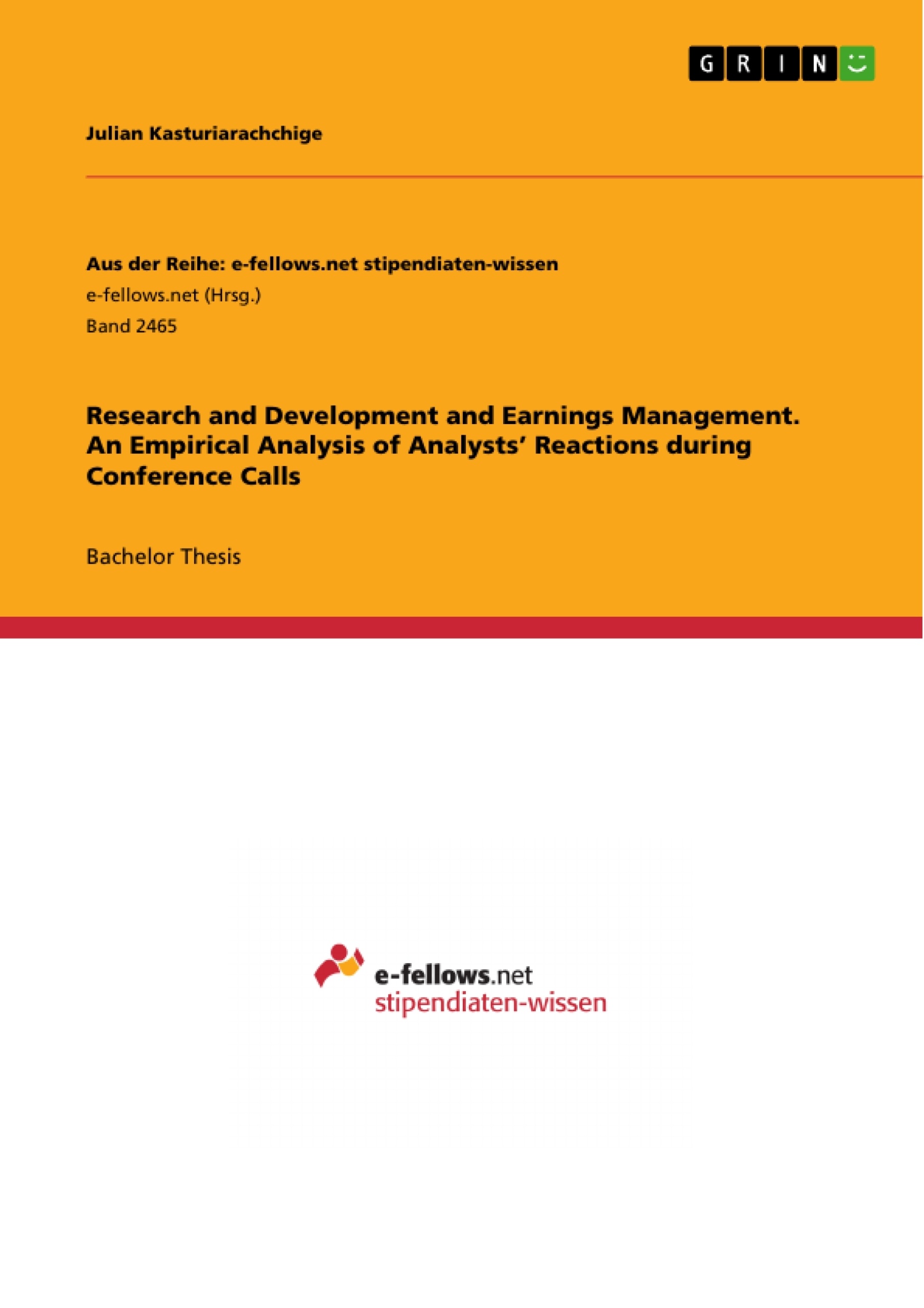This study is an attempt to combine two important streams of accounting research: The problem of earnings management (hereafter EM) and the role of conference calls (hereafter CCs) as disclosure medium. In doing so, I focus on real activities manipulation (hereafter RM) through cutting R&D expenses. I contribute to the existing literature by answering two questions: Firstly, whether the risk of managers engaging in RM via R&D spending affects the probability of analysts, or management addressing those cuts during CCs. Secondly, if the analyst community benefits from such discussions, by obtaining useful information, not accessible via other information channels. To answer these questions, I examine the 4th quarter earnings conference call transcripts of 300 firm years with an increased RM risk. I use content analysis to measure analysts’ and managers’ reactions, and create dummy variables that contain the information found.
Inhaltsverzeichnis (Table of Contents)
- 1. Introduction
- 2. Literature Review
- 2.1. Literature on real activities manipulation
- 2.2. Literature on the information content of Conference Calls
- 3. Hypotheses Development
- 3.1. Discussions and inquiries about R&D cuts during Conference Calls
- 3.2. The information content of Conference Calls with regard to R&D cuts
- 4. Sample Selection
- 5. Definition of Variables
- 5.1. Variables for assessing the probabilities of inquiries and discussions
- 5.1.1. Definition of inquiries and discussion about R&D cuts
- 5.1.2. Definition of control variables
- 5.2. Variables for measuring the information content of R&D cuts
- 5.2.1. Definition of proxies for information content
- 5.2.2. Definition of control variables
- 5.1. Variables for assessing the probabilities of inquiries and discussions
- 6. Test Design
- 6.1. Regression models analyzing inquiries and discussions about R&D cuts
- 6.2. Regression models analyzing the information content of R&D cuts
- 7. Descriptive Statistics
- 7.1. Summary Statistics
- 7.2. Correlation Matrix
- 8. Results
- 8.1. The effect of real activities manipulation on inquiries about R&D cuts
- 8.2. The effect of real activities manipulation on discussions about R&D cuts
- 8.3. The information content of inquiries
- 8.4. The information content of discussing R&D cuts
- 9. Summary and Conclusion
- Appendix
Zielsetzung und Themenschwerpunkte (Objectives and Key Themes)
This research aims to combine the fields of earnings management and conference calls in accounting research, focusing specifically on real activities manipulation (RM) through cutting R&D expenses. The study addresses two primary questions: first, whether the risk of managers engaging in RM through R&D spending influences the likelihood of analysts or management discussing these cuts during conference calls; and second, whether analysts gain valuable information from such discussions that is not available through other channels.
- The relationship between the risk of real activities manipulation and the probability of analysts and managers discussing R&D cuts during conference calls.
- The information content of conference calls regarding R&D cuts and its impact on analysts' forecasting accuracy.
- The role of conference calls as a disclosure medium for information about R&D expenses compared to other information channels.
- The potential use of conference call transcripts for content analysis and extracting valuable information about corporate decision-making and investor communication.
- The effectiveness of analysts as monitors for companies in the context of earnings management and real activities manipulation.
Zusammenfassung der Kapitel (Chapter Summaries)
The introduction sets the stage for the study by introducing the research problem, outlining the objectives, and briefly summarizing the findings. The literature review provides a comprehensive overview of the existing research on real activities manipulation and the information content of conference calls. This section examines various theories and findings related to earnings management, the use of conference calls for disclosure purposes, and the potential motivations behind managers' decisions to manipulate earnings.
The hypotheses development chapter outlines the specific research questions and hypotheses that will be tested in the empirical analysis. It provides a detailed explanation of the rationale behind these hypotheses, drawing upon existing literature and theory. The sample selection section describes the data used for the study, including the selection criteria and the characteristics of the sample firms. The definition of variables chapter outlines the key variables that will be used in the empirical analysis and provides detailed definitions and explanations of their measurement.
The test design chapter outlines the specific statistical methods that will be used to test the research hypotheses. It provides a detailed description of the regression models that will be employed and the variables that will be included in each model. The descriptive statistics chapter presents the key descriptive statistics for the variables used in the study, providing insights into the characteristics of the sample data.
Schlüsselwörter (Keywords)
The primary focus of this research is on the intersection of earnings management, real activities manipulation, conference calls, and analyst behavior. The study examines the use of R&D spending as a tool for earnings management and explores how analysts and managers interact during conference calls to discuss these decisions. Key terms include: real activities manipulation, earnings management, conference calls, analyst behavior, R&D spending, information content, forecast dispersion, and forecast error.
- Quote paper
- Julian Kasturiarachchige (Author), 2015, Research and Development and Earnings Management. An Empirical Analysis of Analysts’ Reactions during Conference Calls, Munich, GRIN Verlag, https://www.grin.com/document/369388



